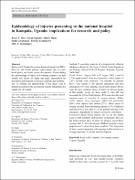| dc.contributor.author | Hsia, Renee Y. | |
| dc.contributor.author | Ozgediz, Doruk | |
| dc.contributor.author | Mutto, Milton | |
| dc.contributor.author | Jayaraman, Sudha | |
| dc.contributor.author | Kyamanywa, Patrick | |
| dc.contributor.author | Kobusingye, Olive C. | |
| dc.date.accessioned | 2022-04-05T15:28:28Z | |
| dc.date.available | 2022-04-05T15:28:28Z | |
| dc.date.issued | 2010-07-20 | |
| dc.identifier.citation | Hsia, R.Y., Ozgediz, D., Mutto, M., Jayaraman, S., Kyamanywa, P. and Kobusingye, O.C. (2010). Epidemiology of injuries presenting to the national hospital in Kampala, Uganda: implications for research and policy. International journal of emergency medicine, 3(3), pp.165-172. | en_US |
| dc.identifier.issn | 1865-1372 | |
| dc.identifier.issn | 1865-1380 | |
| dc.identifier.uri | http://hdl.handle.net/20.500.12280/2903 | |
| dc.description.abstract | Background
Despite the growing burden of injuries in LMICs, there are still limited primary epidemiologic data to guide health policy and health system development. Understanding the epidemiology of injury in developing countries can help identify risk factors for injury and target interventions for prevention and treatment to decrease disability and mortality.
Aim
To estimate the epidemiology of the injury seen in patients presenting to the government hospital in Kampala, the capital city of Uganda.
Methods
A secondary analysis of a prospectively collected database collected by the Injury Control Centre-Uganda at the Mulago National Referral Hospital, Kampala, Uganda, 2004-2005.
Results
From 1 August 2004 to 12 August 2005, a total of 3,750 injury-related visits were recorded; a final sample of 3,481 records were analyzed. The majority of patients (62%) were treated in the casualty department and then discharged; 38% were admitted. Road traffic injuries (RTIs) were the most common causes of injury for all age groups in this sample, except for those under 5 years old, and accounted for 49% of total injuries. RTIs were also the most common cause of mortality in trauma patients. Within traffic injuries, more passengers (44%) and pedestrians (30%) were injured than drivers (27%). Other causes of trauma included blunt/penetrating injuries (25% of injuries) and falls (10%). Less than 5% of all patients arriving to the emergency department for injuries arrived by ambulance.
Conclusions
Road traffic injuries are by far the largest cause of both morbidity and mortality in Kampala. They are the most common cause of injury for all ages, except those younger than 5, and school-aged children comprise a large proportion of victims from these incidents. The integration of injury control programs with ongoing health initiatives is an urgent priority for health and development. | en_US |
| dc.language.iso | en | en_US |
| dc.publisher | BMC , Campus, 4 Crinan St, London, England, N1 9XW | en_US |
| dc.relation.ispartofseries | International Journal of Emergency Medicine;3 | |
| dc.subject | Epidemiology | en_US |
| dc.subject | Injuries | en_US |
| dc.subject | Research and Policy | en_US |
| dc.subject | Uganda | en_US |
| dc.title | Epidemiology of Injuries Presenting to the National Hospital in Kampala, Uganda: Implications for Research and Policy | en_US |
| dc.type | Article | en_US |


